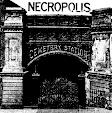ON THE TWENTY-FOURTH NIGHT OF HALLOWEEN … I watched The Plague of Zombies (1966), a Hammer House of Horror film directed by John Gilling. It was made in the golden age of Hammer, after the company had established itself by resurrecting the standard gothic monsters with The Curse of Frankenstein in 1957, The Horror of Dracula in 1958, and The Mummy in 1959 (all three starring Hammer’s premiere duo, Peter Cushing and Christopher Lee). By this point Hammer had also done their own takes on Dr. Jekyll and Mr. Hyde with 1960’s The Two Faces of Dr. Jekyll and the wolfman with 1961’s The Curse of the Werewolf. Hammer managed to make the staple creatures of gothic horror sensational again-- with Universal's versions having gotten stale in the late 40’s-- by rendering them in a distinctly British house style that was much more lurid than earlier iterations.
So, to make a zombie movie, Hammer followed the same recipe: cherry-pick elements from the American classics of the genre, namely White Zombie (1932) and I Walked with a Zombie (1943), and spice them up with more suggestive eroticism and graphic violence. This means, though, that Plague of Zombies’ narrative is squarely cast in an older, now widely forgotten zombie mold, one that more closely resembles the actual zombie legends appropriated (for better or worse) by white Hollywood from Haitian Vodou lore. Two years later, George Romero’s Night of the Living Dead (1968) would introduce the species of zombie that has since completely overwritten the original in the popular imagination. Romero innovated on the myth by subtracting from it: he removed the Vodou magic responsible for creating zombies, thereby removing the purpose for their creation. Romero’s zombies just happen by accident, and no one controls them. That’s not how it works in Plague of Zombies, or in the earlier movies it's modeled on. Here, an evil sorcerer must deliberately target the dead with spells to make them rise from the grave, and the sorcerer does this so as to press them into undying slavery.
The Plague of Zombies’ plot works like a paranormal detective story. A renowned Victorian-age doctor receives a letter from his former pupil telling of a mysterious illness afflicting the Cornish village where he now practices medicine. The doctor travels there with his daughter to investigate. We follow him as he proceeds to dig up graves and find the coffins empty, interrogate surly locals, examine the bloody corpse of his daughter’s school friend, consult the vicar’s convenient collection of occult tomes, and finally leap to the wild conclusion—which naturally turns out to be right on the money—that the town squire moonlights as a necromancer (having acquired his unholy powers during a recent holiday in Haiti). Near the end, we learn that the squire has murdered half the village and reanimated them so as to make them toil for him in his mine. I suppose he does this as a cost-cutting measure, which might seem quite drastic but is totally in character with 19th century mine owners (and 21st century capitalists).
This film has been described as supplying the missing link between older quasi-authentic zombies and Romero zombies, but in fact its zombies follow all the rules of the former. Only a dream-sequence scene where the undead claw their way out of their graves and hungrily corner a man reminded me of Romero. However, this lack of innovation on the legacy zombie wasn’t a drawback for me. I quite like this type of zombie. The idea of a sorcerer or mad scientist (like Re-Animator’s Dr. West) deliberately creating walking corpses to serve as slaves, only to have them turn on their creator, is quite rich, so I enjoyed seeing Hammer’s take. Also, the unique cinematic atmosphere of peak Hammer horror—that technicolor swathed in fog and cobwebs look—is always a welcome treat.


No comments:
Post a Comment